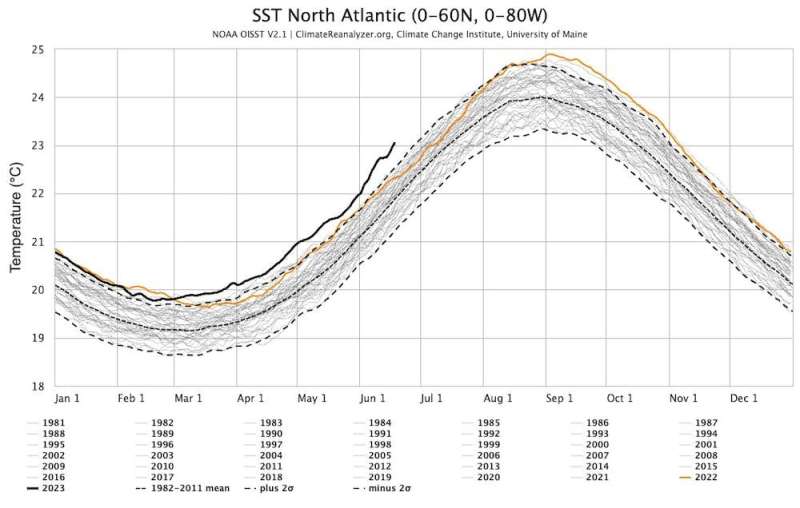This article has been reviewed according to Science X's editorial process and policies. Editors have highlighted the following attributes while ensuring the content's credibility:
fact-checked
trusted source
proofread
An 'extreme' heat wave has hit the seas around the UK and Ireland. Here's what's going on

One of the most severe marine heat waves on the planet is taking place in the shallow seas around the U.K. and Ireland. That's according to the U.S. National Oceanic and Atmospheric Administration (NOAA), which has labeled this a "Category 4" heat wave. Rarely used outside of the tropics, a cat 4 heat wave means "extreme" heat.
Marine heat waves are classified as "prolonged periods of anomalously high sea surface temperature," when compared to the long-term average for that time of year. And thanks to measurements made by satellites orbiting the earth we know that, in some areas around the U.K., surface water temperatures are 4°C to 5°C above normal for mid June.
This is extremely unusual. Buoys around Ireland and the U.K. have been recording sea surface temperature for more than 20 years, and in that time it has never been this hot this early in the summer.
The heat wave is strongest in the northern North Sea, northwest of Ireland, and the Celtic Sea between Cornwall and southern Ireland. However, in other areas, such as the southern North Sea, the English Channel and the southern Irish Sea, the surface temperatures are only a degree or so above normal.
The two regions are very different in oceanographic terms. The latter areas tend to be shallower (30–40 meters) with stronger tidal currents and so the water remains well mixed from the surface to the sea bed, all year around. In contrast, the regions where the heat wave is strongest are deeper (80–100 meters) with weaker tidal currents. As the mixing is weaker these seas "stratify" each summer, with a layer of warmer water overlying the cooler deeper layer.
In these seasonally stratifying regions the heat from the sun only warms the relatively shallow surface layer, while in the mixed regions the sun's impact is diluted as its heat is mixed through the ocean from seabed to surface.
Oceans are slow to warm up and cool down
The temperature of the atmosphere can vary a lot day to day. You might find yourself wearing a jumper on Monday but shorts and a t-shirt by Wednesday. But oceans are different—their ability to absorb lots of heat means temperature varies slowly and extremes are rare.
In seasonally stratified regions the stratification starts to develop in late May, with the maximum sea surface temperatures happening in August. At these locations you would still only expect the temperature to vary by 10°C or so over the whole year (in contrast with the atmosphere where such shifts happen in a matter of hours).
In this latest heat wave, the sea surface is up to 5°C warmer than normal two months before we'd expect to see the maximum temperatures.
North Atlantic temperature patterns
Part of the reason for these anomalously high temperatures in stratified seas could be that the surface layer is shallower than usual and so the sun's heat is more concentrated (probably a result of relatively stable weather and lack of Atlantic storms crossing the U.K. in the past month). As such, these already very warm areas will warm further until a sufficiently strong storm comes along and mixes the heat down into a thicker surface layer.
Fish may go hungry
One reason this heat wave is so significant is that those stratified seas on the continental shelf around Britain and Ireland are some of the most biologically productive on the planet. They have long been an important area for fishing cod, haddock, mackerel and other species. Those fish eat smaller fish and crustaceans, which in turn feed on microscopic plants known as plankton.
At this time of year, these plankton are dependent on nutrients mixed up from the deep water into the surface layer. However, this year, this nutrient supply may be diminished, since the very high surface temperature means there is likely stronger stratification and less mixing.
A heat wave on the surface could potentially harm the deeper ocean too, and the fish that live there. These continental shelf seas are already suffering from a decline in deep water oxygen, which is partly offset by mixing oxygen-rich water from the surface. However, the fact that the surface temperatures are so high point to a lack of mixing between the layers, and in any case, warmer water contains less oxygen.
On a slightly longer timescale, we already know that climate change is affecting these seas. Some warm water fish species are appearing in U.K. waters for instance, and native fish reproduction cycles and those of the plankton they feed on are no longer in perfect sync. This extreme heat wave may be a sign of further changes to come.
Provided by Bangor University





















